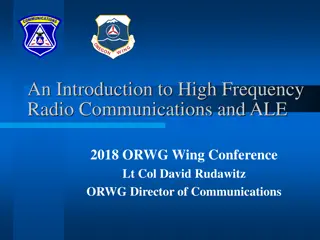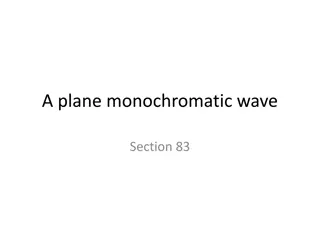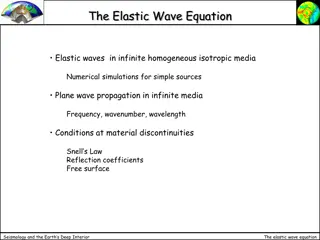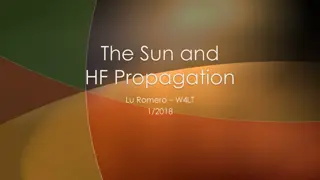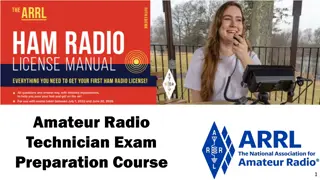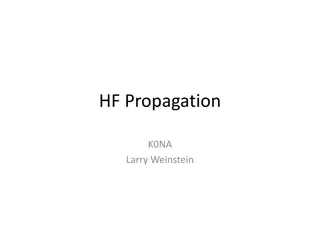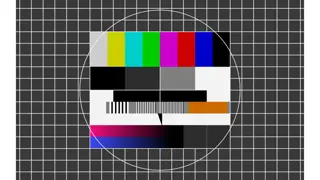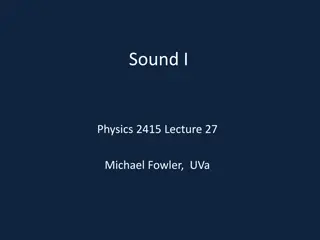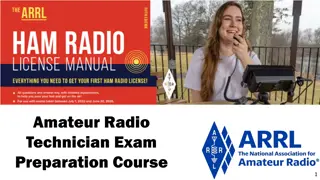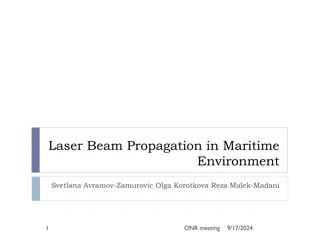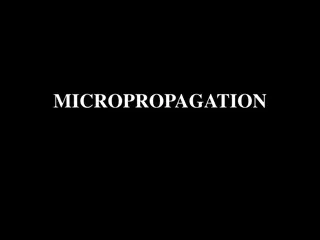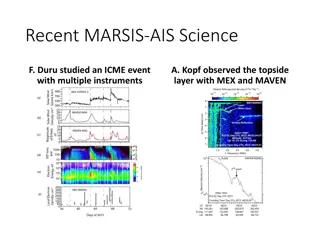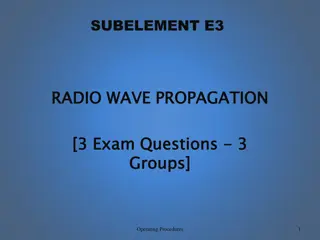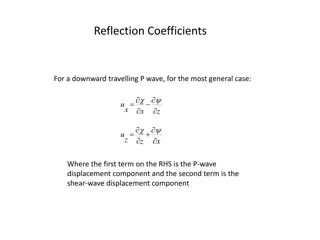Understanding Radio Wave Propagation in the Ionosphere
Radio wave propagation in the ionosphere is influenced by factors such as the radio refractive index and absorption of radio wave energy. This chapter delves into the interaction of radio waves with the ionosphere, discussing concepts like the electromagnetic spectrum nomenclature and the frequency dependency of the refractive index. The absorption of radio wave energy passing through the ionosphere involves the transfer of energy to free electrons and potential attenuation due to collisions with neutral particles. Understanding these phenomena is crucial for effective communication and propagation of radio waves.
Download Presentation

Please find below an Image/Link to download the presentation.
The content on the website is provided AS IS for your information and personal use only. It may not be sold, licensed, or shared on other websites without obtaining consent from the author. Download presentation by click this link. If you encounter any issues during the download, it is possible that the publisher has removed the file from their server.
E N D
Presentation Transcript
Chapter Four Chapter Four Radio Wave propagation Dr. Ali
Introduction Before discussing how ionosphere influences radio propagation, it is necessary to describe some related concept, like the radio refractive index, interaction of radio waves with the Ionosphere, reflection of radio waves by the Ionosphere. The electromagnetic radiation of the Sun is continuum; it spans radio waves through the infrared, visible, ultraviolet, x-ray, and beyond. Table (1.1) below specifies the designated nomenclature for those frequencies used in communications.
Table (1) Electromagnetic Spectrum Nomenclature Frequency Rang Designation Classification 30-300 Hz ELF Extreme Low Frequency 3-30 KHz VLF Very Low Frequency 30-300 KHz LF Low Frequency 0.3-3 MHz MF Medium Frequency 3-30 MHz HF High Frequency 30-300 MHz VHF Very High Frequency 0.3-3 GHz UHF Ultra High Frequency 3-30 GHz SHF Super High Frequency 30-300 GHz EHF Extremely High Frequency
Radio Refractive Index of the Ionosphere If the collisions between electrons and neutral molecules are neglected as a first approximation, an ionized gas is treated as a perfect dielectric then the radio refractive index of an ionized gas could be expressed by the following relationship: 8 . 80 1 f N = 2 N is the number of electrons per cubic centimeter, and f is the frequency of the radio waves. This expression for the refractive index is unusual in more than one respect. 1. First, the absolute value of the refractive index is less than unity, whereas all solids, liquids and gases have a refractive index more than unity. 2. Second, the refractive index of the ionospheric media is frequency dependent.
Absorption of Radio Wave Energy Passing through the Absorption of Radio Wave Energy Passing through the Ionosphere Ionosphere 1. When a radio wave enters the ionosphere and encounters a significant concentration of free electrons, some energy of the radio wave transferred to the electrons, which are thus set into oscillation at the same frequency as that of the radio waves.
2. The electrons can lose some of this energy a result of collisions with neutral particles (atoms or molecules) in the upper atmosphere and it results in attenuation of radio waves when passing through the ionosphere. But if there are no such collisions, the oscillating electromagnetic waves at the same frequency and restore the original radio waves without loss. electrons will reradiate 3. Appreciable attenuation of radio waves can occur in the D-region where collisions of electrons with neutral particles is more due to the higher density of neutral molecules as compared to upper regions of the ionosphere like E and F layers.
Refraction Refraction and and Reflection Reflection of of Radio Radio Waves Waves in in the the Ionosphere Ionosphere 1. It is evident from the equation of Refraction index of a radio wave passing through an ionized media, have N electrons, that for a given frequency "f " the refractive index decreases when radio waves passes from a medium of lower to higher electron density. 2. Hence a beam of radio waves going upward the ionosphere will be refracted downward, (i.e. the angle with the vertical increases when the electron density increases and hence a radio wave will refracted downward).
3. Now, consider the radio wave of frequency f enters the ionosphere in which the electron density increases with altitude. Firstly, the electron density N, in equation (1) is very small and the velocity is near the velocity of light c. 4. As N increases, with constant f, the phase velocity Vpmust increases while the refractive index decreases. Eventually, when the argument of the square root in equation (1) becomes zero, the refractive index will be zero, and in such case, N will represent critical electron density Nc.
5. At this density, the radio wave can no longer propagated in the forward (upward) direction and it will reflected back to the Earth. The critical frequency fcof a layer is given by:
Types of HF Propagation High Frequency (3 to 30 MHz) radio signals can propagate to a distance receiver via two methods, these method are: 1. Ground-Wave Propagation A propagated ground wave takes three separate paths to the receiver. They are the direct wave, the ground-reflected wave, and the surface wave, as shown in Figure (1). The effectiveness of ground waves depends on the radio frequency, transmitter power, transmitting antenna characteristics, electrical characteristics (conductivity and dielectric constant) of the terrain, and electrical noise at the receiver site. Low and very low frequencies were propagated much better by surface path than are higher frequencies. When high-powered transmitters and efficient antennas are used, the surface path has a maximum range, of about 500 km, at 2MHz. Surface path range decreases as frequency increases. The distance 80km represents the usual minimum range.
2. Sky-Wave Propagation Radio waves in the low frequency (LF) and medium (MF) ranges may also propagate as ground waves, but suffer significant losses or attenuated, particularly at higher frequencies. But as the ground wave mode fades out, a new mode develops, it is called the sky wave. Sky waves are reflected from the Ionosphere. While the wave is in the ionosphere it is strongly bent, or refracted, ultimately back to the ground. For a long distance way this appears as a reflection. Long ranges are possible in this mode, up to hundreds of miles. Sky waves in this frequency band are usually possible at night only, when the concentration of ions is not too great. At night, there are just enough ions to reflect the wave but not reduce its power too much.
The HF band operates almost exclusively with sky waves. The higher frequencies have less attenuation and less refraction in the ionosphere as compared to MF. At the high end, the waves completely penetrate the Ionosphere and become space waves. At the low end, they are always reflect. The HF band operates with both these effects almost all of the time. The characteristics of the sky wave propagation depend on the conditions in the ionosphere, which in turn are dependent on the activity of the Sun.






